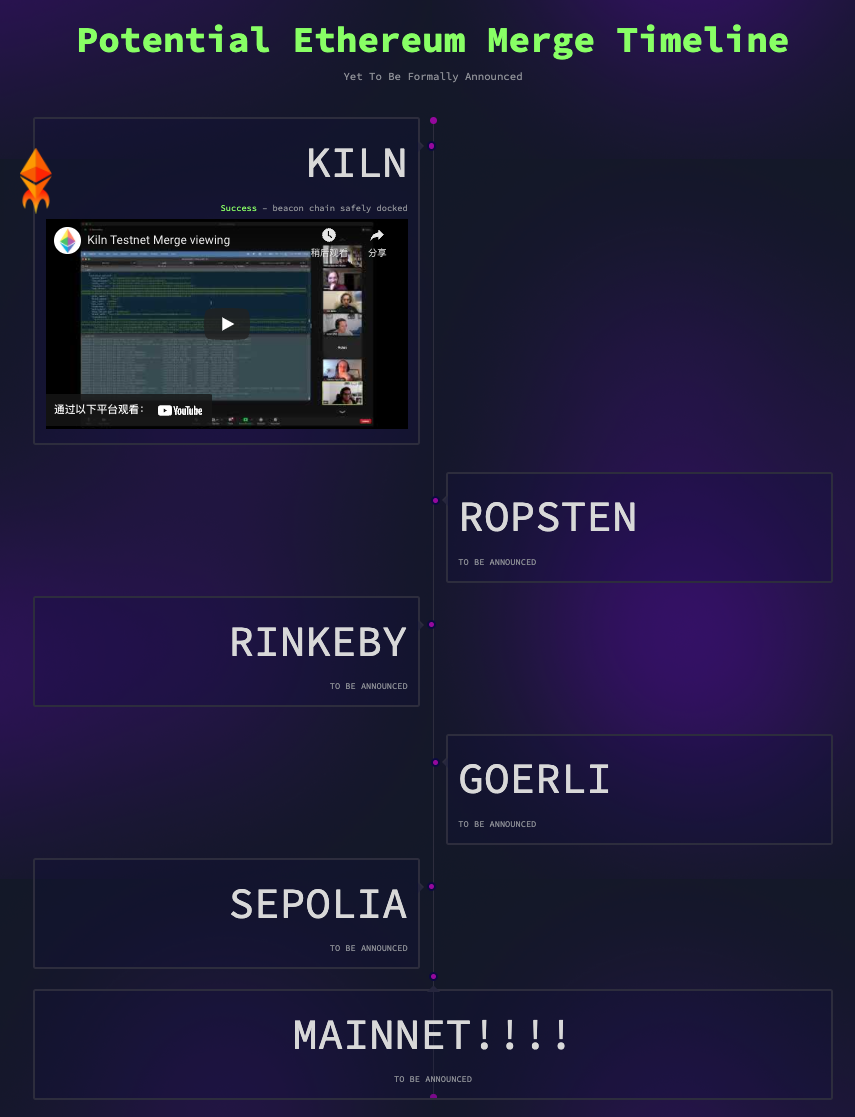The Merge升级成功后,对以太坊生态会产生哪些影响?
以太坊自推出开始,便清晰的绘制了未来开发的路线图。在最初的设想中,以太坊将一共需要经历四个主要开发阶段,他们分别是:边境(Frontier)、家园(Homestead)、都会(Metropolis)以及宁静(Serenity)。
截止目前,前三阶段的升级目标已经于 2020 年前基本完成。以太坊近两年的主要开发工作已经集中到完成最后一个阶段的升级任务中。而在最初的设想中,宁静(Serenity)阶段升级的主要目标,是将以太坊从目前的 PoW 工作量证明机制切换到更加节能的 PoS 机制。
名称频繁修改,升级一拖再拖
随着以太坊推出后链上生态的逐步发展,许多之前没有预料到的新问题被不断发现。因此,早年间提出的升级计划也被不断修改和完善。
2017 年,以太坊 2.0 的概念被开发团队提出。新的以太坊 2.0 升级计划基本包含了之前宁静(Serenity)升级的主要内容,并针对已经出现的扩展性难题,提出了分片的全新解决思路。在当年,整个 2.0 升级方案计划在 2020 年最终完成。
在以太坊 2.0 升级计划中,整个升级将分为 3 个独立的阶段,他们是:
Phase 0 阶段:完成 PoW 向 PoS 的转换;
Phase 1 阶段:增加分片;
Phase 2 阶段:升级虚拟机和执行环境;
当然我们已经看到,截止到今天也就是 2022 年,曾经以太坊 2.0 升级计划中的 Phase 0 阶段依然没有完全落地。
不过在升级计划不断跳票的这几年中,区块链底层技术也在不断发展完善。尤其随着 Rollup 扩容技术的异军突起,以太坊基金会又对升级目标进行了修改,以便更好的结合 Rollup 技术完成以太坊的扩容。
最终在今年年初,以太坊基金会对整个以太坊 2.0 升级计划以及名称进行了重新修订。在最新的路线图中,曾经的以太坊 2.0 概念被弃用,以避免用户将以太坊 2.0 与现在运行的以太坊 1.0 完全对立起来。
因为事实上,目前运行的以太坊主网并不会在升级后被弃用,而是和目前已经上线的以太坊 Beacon Chain 合二为一。因此在合并后,目前一直良好运行的以太坊主链将会依然存在,并被命名为新版以太坊的「执行层」,而于 20 年启动的 Beacon Chain 将成为新以太坊的「共识层」,主要负责以太坊的安全与共识工作。
在新版路线图中,整个升级过程依然分为三个阶段,分别是:
1. 信标链(Beacon Chain):信标链目前已经上线,该链将成为未来以太坊分片的核心。当前用户质押的以太坊就保存在这条信标链上;
2. 合并(The Merge):合并阶段是我们即将面临的升级,包括将 PoW 切换到 PoS,以及目前以太坊主链与信标链的合并工作,因此本阶段也被称为 The Merge;
3. 分片链(Shard Chain):在这个阶段,以太坊将从一条链扩展到共有 36 条分片链的最终状态,预计交易性能将随着分片的实施极大提高;
The Merge 升级前的准备工作
为了防止在正式升级中出现任何不可控的风险,官方团队将推出多个测试网以进行合并的测试工作。截止目前,以太坊开发团队已经推出了两代测试网,分别是 Kintsugi 测试网,以及目前正在运行的 Kiln 测试网。
在测试阶段,正在运行的 Kiln 测试网已经成功合并了多个 devnet。根据规划,下一步 Kiln 将会开始逐步合并以太坊主网的测试网,也就是我们在 MetaMask 钱包中经常见到的 Ropsten、Rinkeby 等测试网。
如果在下一阶段的测试中依然没有发现重大问题,那么预计马上将会开始进行主网合并的准备工作。
关于测试进行的具体阶段,用户可以通过访问 wen merge?(https://wenmerge.com/)网站,跟踪测试的最新进度。如果在接下来的几次合并测试中没有出现重大故障,那么最终主网的升级可能会被马上提上日程。

The Merge 预计何时发生?
首先需要说明的是,目前官方依然没有给出任何明确的升级时间。但根据种种迹象推测,如果一切顺利,合并(The Merge)将于今年 6 月前后发生。
具体的推测过程可以参见律动 BlockBeats 之前翻译的一篇文章:《为什么以太坊一定会在 2022 年 6 月之前完成合并?》(https://www.theblockbeats.info/news/29750)
The Merge 升级成功后会产生哪些影响?
1. 以太坊抛售压力大大降低
在 The Merge 升级前的 PoW 阶段,以太坊每天需要增发约 12,000 个 ETH。由于矿工参与 PoW 挖矿需要耗费大量的能源,这些增发的 ETH 中的大部分都被矿工直接出售以支付维护矿机所产生的电力与运营成本。
而在以太坊转为 PoS 后,以太坊的增发量将减少到每天 1,280 个 ETH,约为之前的 10%。此外,由于运行一个验证节点的电力成本大大降低,因此节点运营商将不再需要大量出售增发的 ETH 以维持运营,并可能会将部分新增的 ETH 重新投入质押以提高收益。因此预计整个市场由矿工出售的 ETH 数量将大大减少。
因此,合并后 ETH 的增发与抛售压力预计都将大大降低,其效果约等于比特币同时发生三次减半。
2. 信标链中 Stake 的 Token 暂时无法解锁
随着 Beacon Chain 在 20 年的上线,大量 ETH 被质押到 Beacon Chain 上以便赚取质押收益。截止目前,
共有超过 1000 万个 ETH 被质押到信标链中。那么这部分 ETH 是否会随着合并完成而解锁?
根据以太坊开发着在在官方博客中提供的信息,这部分 ETH 预计将不会在合并发生的第一时间重新获得流动性。
由于 The Merge 升级是一次极为复杂的升级过程,为了尽量降低升级过程中可能出现的意外,开发团队在合并中排除了几乎所有与合并无直接关系的功能改进。也就是说,像解锁 PoS 质押这种功能性升级,将会在合并结束并稳定运行一段时间后的下一步升级中,才会被添加到主网中。
因此,之前在 Beacon Chain 中质押过 ETH 的用户,预计还需要等待一段时间才能解除质押,使得这部分 ETH 重新恢复流动性。
3. 大量高端显卡退出挖矿回流市场
由于目前最主要的显卡挖矿公链以太坊转变为 PoS 机制,届时预计会有大量用于以太坊挖矿的显卡重新流入市场。曾经一卡难求的局面预计将会大大缓解。(在不分叉的前提下)
4. 能否解决以太坊 gas 过高的问题?
不一定。
以太坊 gas 的成本由市场供需直接决定。而 The Merge 升级并不能从根本上改变以太坊计算量的供给限制,预计也不会显著影响用户对以太坊链上计算的需求。
短期内,以太坊 gas 的高低可能依然由市场整体热度,是否有热门项目等需求侧波动所决定。若想彻底改善 gas 成本过高的问题,需要等待以太坊在供给侧作出显著改善,这也是下一阶段分片链升级的主要目标。
虽然官方目前预计分片链升级将于 2023 年推出,但考虑到以太坊升级的整体难度,以及之前升级计划频频跳票的历史,因此下一阶段分片升级的话题,还是让我们等待以太坊基金会准备充分后,再来详细讨论吧。



